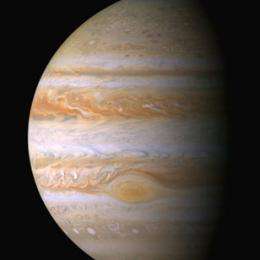STAR TRAK for October

As the short nights of summer give way to the longer nights of autumn in the Northern Hemisphere, Jupiter will come into view above the southeastern horizon as the sun sets. The huge planet will be much brighter than any other object in the sky this month, reaching opposition on the night of Oct. 28-29. Since it will be opposite the sun in our sky, it will be visible all night, reaching its highest point in the south around midnight.
Opposition also marks a planet's closest approach to Earth, so Jupiter will be a magnificent sight in any telescope. For the best views, wait until mid-evening when it will be above the atmospheric turbulence close to the horizon. In addition to the planet's many surface features, at least four of its moons will be visible. Galileo first observed these moons in 1610 and immediately realized their importance: they showed that Earth is not the center of all celestial motions, as nearly everyone before then had believed.
Venus will be visible very low in the southwest shortly after sunset. For viewers at mid-northern latitudes, it will set just a half hour after the sun at the beginning of the month and about an hour after sunset by month's end.
Mercury will appear below Venus in the last week of October, so low in bright twilight that binoculars will be needed to see it.
Mars passed through the Beehive star cluster of the constellation Cancer the Crab on the morning of Oct. 1, providing a fine sight in binoculars and telescopes as well as a great opportunity for photographs. The red-orange planet rose around 2 a.m. local time and was high in the southeast by dawn. It will spend the rest of the month moving toward the bright white star Regulus in the constellation Leo the Lion.
Saturn will pass through conjunction with the sun on Oct. 13, emerging into the morning sky during the second half of the month. On Oct. 31, about a half hour before sunrise, the yellow planet will be almost 10 degrees high in the east-southeast with the bright white star Spica nearby to its right.
Meteor shower
The Orionid meteor shower will peak before the first light of dawn on Oct. 22. Try watching around 2 a.m. local daylight saving time, shortly before the third-quarter moon rises. The Orionids appear to originate from the constellation Orion the Hunter. Orion will rise before midnight in the east southeast, and the number of meteors will increase as it gets higher above the horizon. The shower will be active for most of October, with the number of meteors gradually increasing from the start and declining after the peak. The Orionid meteors are dust particles from Halley's Comet, left behind in the comet's orbit.
Moon phases
The moon will be at first quarter on Oct. 3, full on Oct. 11, at third quarter on Oct. 19 and new on Oct. 26.
This year astronomers have designated Oct. 8 as Observe the Moon Night. Groups around the world have planned events for this night. For details, visit www.observethemoonnight.org/.
Provided by Indiana University





















